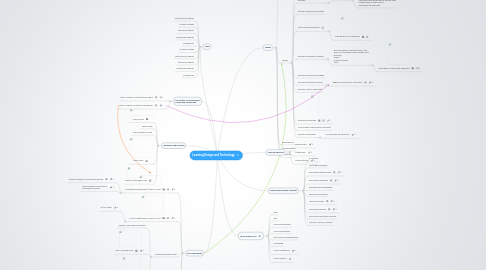
1. Key Frameworks
1.1. Multimedia learning theory(Mayer, 2003)
1.1.1. Seven Principles on multimedia learning
1.1.2. The Cambridge Handbook of Multimedia Learning
1.2. 4C/ID Model(Clark & Croock. 2002)
1.2.1. 4C/ID Model
1.3. Learning by doing model
1.3.1. Schank: case-based reasoning
1.3.2. Kolb: Learning Cycle
1.3.3. Dufour: Learning by doing
1.4. Resource-based learning
1.5. Jonassen: Constructivist learning environment
1.5.1. Jonassen: Constructivist learning environment
2. Learning Design Models
2.1. Linear Model
2.2. Spiral Model
2.3. Top-to-Bottom Model
2.4. Oval Model
2.5. Rapid Prototyping Model
3. The History of Instructional Design and Technology
3.1. Part1: A history of instructional media
3.2. Part2: A history of instructional design
4. Team
4.1. Instructional Designer
4.2. Project Manager
4.3. Interface Designer
4.4. Multimedia Designer
4.5. Programmer
4.6. Project Manager
4.7. Instructional Designer
4.8. Interface Designer
4.9. Multimedia Designer
4.10. Programmer
5. Stages
5.1. Analysis
5.1.1. Needs Assessment
5.1.2. User/Audience Analysis
5.1.3. System/Technology Analysis
5.1.4. Content Analysis
5.1.5. Feasibility Analysis
5.1.6. Risk Analysis
5.1.7. Project Proposal
5.2. Design
5.2.1. Define a Goal(s)
5.2.2. Conduct Instructional Analysis (Performance, Content, Task Analysis)
5.2.2.1. eg. Task Analysis
5.2.2.1.1. Analysis of job description; Analysis of job-related documents; Observation of people at work, directly or via recording; Discussion with people about specific jobs; Extrapolation of tasks from a customer’s training need.
5.2.3. Analyze Learners and Context
5.2.4. Write Learning Objective
5.2.4.1. John Bigg's SOLO Taxonomy
5.2.5. Develop Assessment strategy
5.2.5.1. Drill and practice-Multiple choice, True false, Fill in the blank, short answer, drag and drop Essays Problem-solving Tasks
5.2.5.1.1. John Bigg's Constructive Alignment
5.2.6. Develop Instructional Strategy
5.2.7. Arrange Instructional Events
5.2.7.1. Gagne's nine events of instruction
5.2.8. Develop a set of Flowcharts
5.2.9. Develop Storyboards
5.2.10. Write Design Specification Document
5.2.11. Develop a prototype
5.2.11.1. Tool we used: Axure RP Pro
